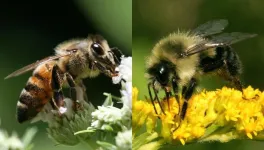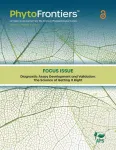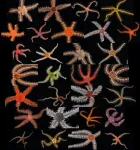(Press-News.org) Annapolis, MD; July 17, 2023—Responsible use of pesticides includes striving to avoid negative effects on the environment, often with an emphasis on protecting bees and other pollinators. A new study, however, finds that many common methods for minimizing pesticides' impact on bees—even some recommendations on product labels—are backed by minimal scientific evidence.
The researchers behind the study say stronger testing is needed to evaluate which bee-protection measures are truly effective and which ones may be too reliant on conventional wisdom. They share their analysis in a report published today in the Journal of Economic Entomology.
Growers are urged to follow a variety of "mitigation measures" meant to protect bees during pesticide applications, such as spraying at night, using specific nozzles on sprayers, or maintaining buffer zones.
"It takes time, money, and effort to follow these rules, so if they are not actually helpful, they are a waste of time," says Edward Straw, Ph.D., a postdoctoral researcher in the School of Agriculture and Food Science at University College Dublin (UCD) in Ireland and lead author on the study. "If they are helpful, though, they could be applied more widely, to protect bees further."
Straw and colleague Dara Stanley, Ph.D., assistant professor in applied entomology at UCD, combed published, peer-reviewed research for studies that evaluated the effectiveness of any kind of mitigation measure in reducing a pesticide's impact on bees. Just 34 studies matched their criteria, spread across a wide range of measures—but largely focused on just one kind of bee.
"Almost all research was centered around protecting honey bees. However, honey bees are a managed species that is not endangered," Straw says. "When we try to protect bees, we really want to be protecting wild, unmanaged bee species, as these are the species which are in decline."
Few mitigation measures had more than one or two studies evaluating their effectiveness, and methods of testing varied. For instance, some studies tested for direct overspray while others tested for longer-term pesticide residues. And just three studies among Straw and Stanley's review evaluated measures frequently found on pesticide labels.
"Least researched was testing on how you time a pesticide spray, be that time of day or time of year," Straw says. "There's good reason to believe that if you change when you spray, you could avoid peaks in bee activity. Yet surprisingly no one has really researched if this idea works. This is odd, as it's a very common mitigation measure and not overly hard to test."
Other mitigation measures tested in existing studies included how pesticides are applied (e.g., spray parameters or planting methods for pesticide-coated seeds), buffer zones, removing flowering weeds before spraying, direct interventions for managed bees (e.g., moving or covering colonies), and applying pesticides only in certain weather conditions or during certain crop stages.
A newer method had the most studies (12) investigating its potential: repellent additives to pesticide sprays, which encourage bees to avoid a recently sprayed crop. Several compounds have shown promise in lab testing, but all 12 studies tested repellency for honey bees only, and none were tested in formulation with a pesticide—only on their own.
"It is an interesting idea, but it is not yet ready to be used," says Straw. "It would need to be tested on a diversity of bee and insect species, as if it is only repellent to one or two species, all the other bees would still be exposed to the pesticide."
In sum, Straw and Stanley say too much hinges on bee-protective measures for them to be weakly supported. Bees play a critical role in both natural ecosystems and agriculture, and the presumption that mitigation measures are effective can be factored into decisions to authorize pesticides for use. Rigorous scientific evaluation of these measures is imperative, they say.
"The main limitation is that these studies need to be big, well-funded pieces of research. To test changes to how a pesticide is applied to a crop, you need to have a crop, a pesticide sprayer, and someone licensed to spray. All of that is expensive and time consuming, making it out of reach for most scientists," says Straw.
But, if such research can be generated, there's reason to believe it will have immediate positive impacts. In related research Straw and Stanely published earlier this year, compliance with pesticide regulations and guidelines among farmers in an anonymous survey was high. "We know that these mitigation measures are being followed," says Straw. "We just do not know if they are helpful yet."
###
"Weak evidence base for bee protective pesticide mitigation measures" will be published online on July 17, 2023, in the Journal of Economic Entomology. Journalists may request advance copies of the article via the contact below or access the published paper after 10 a.m., July 17, 2023, at https://doi.org/10.1093/jee/toad118.
CONTACT: Joe Rominiecki, jrominiecki@entsoc.org, 301-731-4535 x3009
ABOUT: ESA is the largest organization in the world serving the professional and scientific needs of entomologists and people in related disciplines. Founded in 1889, ESA today has more than 7,000 members affiliated with educational institutions, health agencies, private industry, and government. Headquartered in Annapolis, Maryland, the Society stands ready as a non-partisan scientific and educational resource for all insect-related topics. For more information, visit www.entsoc.org.
The Journal of Economic Entomology publishes research on the economic significance of insects and is the most-cited journal in entomology. It includes sections on apiculture and social insects, insecticides, biological control, household and structural insects, crop protection, forest entomology, and more. For more information, visit https://academic.oup.com/jee, or visit www.insectscience.org to view the full portfolio of ESA journals and publications.
END
FEMSelect Ltd., a women-led company developing innovative technologies to make a lasting impact on women's health, today announced positive results from a large six-month safety and outcome study of EnPlace® in 123 women with pelvic organ prolapse, published in the International Journal of Gynecology & Obstetrics(IJGO).
The article, titled The EnPlace® sacrospinous ligament fixation—A novel minimally invasive transvaginal procedure for apical pelvic organ prolapse repair: Safety and short-term outcome results,1 discusses how investigators found that EnPlace, cleared by the FDA for attaching sutures to ligaments of the ...
Giving patients with operable pancreatic cancers a three-pronged combination immunotherapy treatment consisting of the pancreatic cancer vaccine GVAX, the immune checkpoint therapy nivolumab and urelemab, an anti-CD137 agonist antibody treatment, is safe, it increases the amount of cancer-killing immune system T cells in the tumors and it appears effective when given two weeks prior to cancer-removal surgery, according to new research directed by Johns Hopkins investigators. A description of the work was published online June 20 in the journal Nature Communications.
This study, led by researchers at the Johns Hopkins Kimmel Cancer Center, the Bloomberg~Kimmel ...
The nonprofit PhRMA Foundation launched a new grant program to provide more than $1 million in funding for research on the use of digital health technologies (DHTs) in underrepresented populations in clinical trials to advance regulatory decision-making.
Based on applicants’ letters of intent, the Foundation will award up to eight $25,000 planning grants to support the development of detailed research proposals to compete for two $500,000 grants. Planning grant award recipients will also be offered a $5,000 promotional credit from ...
Chestnut Hill, Mass. (7/17/2023) – Putting truth to the test in the “post-truth era”, Boston College psychologists conducted experiments that show when Americans decide whether a claim of fact should qualify as true or false, they consider the intentions of the information source, the team reported recently in Nature’s Scientific Reports.
That confidence is based on what individuals think the source is trying to do – in this case either informing or deceiving their audience.
“Even when people know precisely how accurate or inaccurate a claim of fact is, whether they consider that claim to be true or false hinges on the intentions ...
The vast scale of global trade presents a constant threat of introducing new plant diseases, which is challenging to the United States system of biosecurity. Plant health professionals often must respond quickly to a newly introduced or emerging plant disease outbreak even before a well-validated diagnostic test is available. Additionally, thousands of plant pathogens that already exist have been routinely diagnosed with assays that were not fully or consistently validated, which can lead to inaccurate diagnoses, delays in proper disease management, and significant consequences for growers and the public.
Growing awareness of this gap in coordination and resources for plant disease ...
Political apathy is growing in democracies around the world. Political apathy, also known as political alienation, describes feelings of separation and disaffection, a sense of powerlessness and an indifference to politics and political institutions. A hallmark of political alienation is a refusal to vote or participate in political activities. Adolescents and young adults are no exception to these trends. In many countries in Europe and North America, the youngest voters have the lowest participation rates.
Why are new voters so apathetic about politics? Many factors are ...
Ambitious global $1 billion per year ‘mission science’ model needed to win on sustainable development in time, warns experts
From the climate emergency and global health to the energy transition and water security, new report argues the global science and science funding efforts must be fundamentally redesigned and scaled up to meet complex needs of humanity and the planet.
July 17, 2023, NEW YORK – The current sustainability science model requires a fundamental redesign to keep up with the pace and complexity of the challenges facing the planet, argues the high-level ...
Ophiothrix angulata, a widely recognized and prevalent ophiuroid species in the Western Atlantic, has long been the subject of taxonomic debate due to its remarkable morphological diversity. A new study just published in PeerJ Life & Environment has shed light on the species' taxonomy, revealing a significant scientific breakthrough.
Led by a team of researchers from Universidad Nacional Autónoma de México, Universidad Católica del Maule and Florida Natural History Museum, the comprehensive study aimed to assess species delimitation ...
On the occasion of its annual general assembly in Singapore on 16 July 2023, the International Institute of Welding presented Sergio Amancio, from the Institute of Materials Science, Joining and Forming at Graz University of Technology (TU Graz), with this year’s Yoshiaki Arata Award in recognition of his scientific achievements. This award, consisting of a medal and a certificate, is considered one of the world’s most important awards for research in welding and additive manufacturing and usually goes to veteran researchers who are recognised for their life’s work. For ...
Statement Highlights:
The number of people who use electronic nicotine delivery systems, typically referred to as e-cigarettes, has grown exponentially, especially among youth and young adults. E-cigarette use more than doubled from 2017 to 2019 among middle and high school students.
Ingredients of e-cigarettes, including nicotine, flavoring agents, sweeteners and propylene glycol and vegetable glycerol, may each independently pose dangerous health risks.
More clinical studies on the long-term impact of e-cigarettes on the heart, blood vessels and lungs are needed, and experts emphasize additional molecular and laboratory research ...




